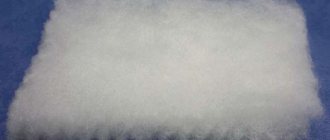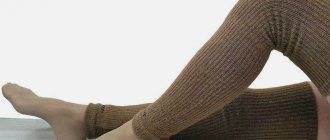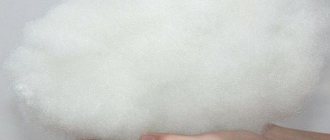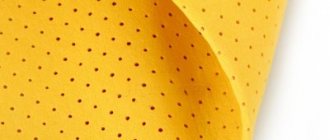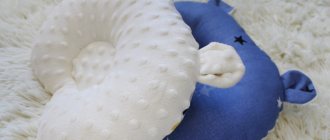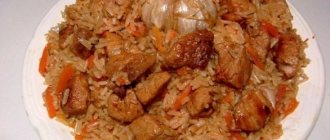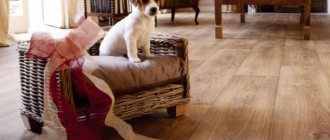At the beginning of the last century, factories began to sew outerwear with polyester fiber insulation. Later, polyester filling was made from it to sew demi-season and winter coats.
Since that time, the material began to be used almost everywhere. Today, well-known brands and companies that sew clothes for the mass market use new technologies in production. Manufacturers can create different types of linings to make it easier for everyone to find a warm jacket.
First, you should find out what kind of material is used for winter clothing. Polyester is a man-made raw material developed from fibers.
To make high quality fabric that is close to natural fabrics, new high-tech equipment is used. Clothes with such fillings can be worn both on chilly autumn days and in winter frosts.
History of fabric, manufacturing process
The moment of invention of polyester (polyester) insulation can be considered the first half of the 20th century, when polyethylene fibers were established. By that time, industrialists were already familiar with the production of nonwoven materials with thermal insulating properties. But other raw materials were used for this: viscose, cotton, linen, wool, polyamide, etc. Tests have shown that polyethylene is not only suitable for this, but is better than other materials in many respects. In addition, the finished filler made from it has a lower cost.
The starting materials for polyester insulation are fibers obtained from oil and gas products through chemical and mechanical action. They are also used for the production of woven materials from polyethylene. We have made a separate article about the pros and cons of polyester fabric. Technology for obtaining material in general terms:
- The raw materials undergo preliminary preparation (loosened, cleaned).
- A fibrous base is formed from the raw material.
- This base is fastened by physical-chemical, mechanical, thermal or combined methods.
- The finished filler undergoes finishing.
Please note: the way the fibrous base is bonded determines what qualities the polyester insulation will have. These are thermal insulation, hydrophobic properties, weight.
Polyester insulation, what kind of filler is in jackets, properties
A little less than a hundred years ago, fabric made from polyester fibers began to be sold. After a certain period of time, polyester heat insulators began to be made from them to fill winter and spring-autumn jackets, after this time it became famous and spread everywhere. New production technologies for linings for outerwear make it possible to make different materials. Anyone can choose at least one suitable one from them.
This is interesting: Birthday Party Ideas
Description of material, cost, composition
Now a little more about polyester, what kind of material it is, is it warm or not and in what form is it produced. To put it in simple words, it is an accumulation of polyethylene fibers, solid or hollow, loosely fastened together. Due to this looseness, many cavities filled with air are formed in the thickness of the insulation. The number of cavities, in turn, depends on the thickness of the insulation and the diameter of the fibers from which it consists. And the more air there is in the thickness of the layer, the more heat it will retain.
Insulation materials made from polyester can be divided into two types:
- Volumetric fillers, the number of air cavities in which increases due to the thickness of the material itself. The most budget option is padding polyester. Its initial cost is less than 200 rubles. per linear meter. More expensive, but better - Thinsulate, from 450 rubles. per linear meter.
- Thin-layer materials, where the small thickness of the filler is compensated by the small thickness of the fibers, which provides a sufficient number of air cavities in the layer. The cheapest variety is polyester fleece. It will cost you from 250 rubles. for 1 meter. There is also a more advanced version, depending on the manufacturer, such a canvas can cost from 350 (Korean) to 2500 rubles (original, produced by Polartec® LLC).
The composition of the fillers - insulation in question - is 100% polyester, or the same, but with a small inclusion of other fibers.
Thinsulate
Of all the insulation materials made from polyester fiber, Thinsulate is the lightest and warmest. No wonder it is compared to natural swan down. This artificially created material has all the positive qualities of down and at the same time is devoid of its disadvantages.
Thinsulate, consisting of microscopic fibers surrounded by an air shell, is capable of retaining heat and warming the human body at temperatures as low as -60 °C. Moreover, the insulation is not too thick, and the clothes turn out to be light and not bulky.
This material is used to make warm clothes for polar explorers and oil workers, and sew comfortable equipment for climbers. The only drawback of clothes filled with Thinsulate is the high cost.
Types of materials and their main characteristics
Here we present the most popular filling options with their main characteristics: density and thickness of 100% polyester insulation, for what weather (temperature).
- Sintepon. The method of bonding fibers is chemical or physical. Density 100, 150, 200 g. and 300 g/m2. Thickness from 0.7 to 4 cm. Minimum comfortable temperature - up to -20 C°.
- Synthetic fluff. The fibers are spiral-shaped, elastic and elastic. 1st grade and 2nd grade, 1 is more elastic and uniform. Temperature from +5 to -30 C°. Sold by weight.
- Holofiber. Types Volumetric, Soft (with calender), Ecosoft. It is manufactured in the form of layers of different thicknesses, light and flexible. Density from 70 to 300 g/m2. Temperature from +5 to -30 C°. Here, by the way, for those who were interested in the topic “holofiber or polyester, which is better”: as you can see, it’s the same thing.
- Thinsulate. Polyester fibers are thinner (up to 10 times) than in other insulation materials, are siliconized and twisted into spirals. Density from 101 to 420 g/m2, thickness from 0.8 to 1 cm. Depending on the type, from +5 to -30, extremely up to -60 C°.
- Isosoft. The finest polyester fiber, comparable in quality to Thinsulate. The canvas is covered on both sides with a calender (polymer coating). Density from 80 to 250 g/m2, thickness from 0.7 to 2.2 cm. From +5 to -25 C°.
- Thermofinn is a polyester filler, what is it: a mass of hollow crimped and solid bicomponent fibers, the fabric is enclosed in a calender. Density 100, 150 and 200 g/m2, thickness - from 1.2 to 2.7 cm. From -15 to -55 C°.
- Polartek. Thin pile on a non-woven basis, with one to three layers of protective coating. It has moisture and windproof properties. From -10 to -15 C°, with high human activity - up to -20.
- Fleece. Thin pile on a non-woven basis, without coatings. Can be used as a lining, with a density from 100 to 600 g/m2. Without a second layer of clothing – up to +10 C°.
Don’t forget that how warm 100% polyester will be for you—what minimum temperature it is suitable for—depends not only on how cold the air “outside” is. Your activity level matters a lot. It is always warmer when you walk quickly, but if you stand in one place, you can freeze even at 0 C°.
Insulation for winter clothes
Holofiber SOFT. Lightweight, elastic and heat-resistant material. Even in frosty weather and temperatures of -25 °C it will retain heat and protect against hypothermia.
Thinsulate. Its structure resembles natural fluff. New technologies allow it not to lose its shape, repel moisture and participate in heat exchange. Provides excellent warmth at -30°C.
Belarusian Fibertek. Hypoallergenic, lightweight and durable. Temperature fluctuations up to -40 °C. An ideal solution for long walks in the fresh air.
American brand PrimaLoft. The basis for the creation was the imitation of the characteristics of down, but with an improved structure and use of fiber. This type is designed specifically for outdoor activities and sports, provided that the temperature does not reach -20 °C.
Belgian Isosoft. The presence of a double spunbond fabric gives additional density and lightness to the filler. The possibilities are limited by cold down to -20 °C.
Properties, pros and cons
The main criterion that polyester must meet is whether it is warm in winter (or under it). This refers to the level of heat retention under clothing/blanket. Also, these fillers should not create a “greenhouse” effect. And everything else - hydrophobicity, wind protection, abrasion resistance - is secondary, because insulation, as a rule, is always covered with a layer of protective fabric. Of course, unless otherwise stated by the manufacturer.
Advantages of polyester insulation:
- Good heat retention with low filler weight. In some species - even with a small thickness.
- Does not require maintenance.
- After creasing, it quickly returns to its previous shape.
- You can always find inexpensive options.
- Insensitive to alkalis and inorganic acids.
Minuses:
- The cheapest varieties, if they are not quilted, begin to bunch up after a while. Literally 5 washes, and comparing which is warmer, polyester padding or padding polyester is no longer useful.
- Almost all polyester insulation materials, when exposed to water, quickly absorb it, losing their heat-protective properties. The exception is some types of Isosoft, Polartek and Tensulate.
- May become deformed at temperatures above 40 C°.
- Dissolves under the influence of acetone, gasoline, benzene, ethyl acetate and liquids containing these substances.
Please note: a chemical method is often used to bind the fibrous base in cheap insulation materials. If the production technology is violated, the material may contain residual traces of harmful substances. Such fillers can be hazardous to health or simply cause allergic reactions.
How to distinguish one filler from another and not buy a fake?
When choosing a down jacket or down jacket, it is important to understand what tasks the new item will perform. Synthetic insulation is ideal for active people and those who suffer from allergies
In order not to buy a fake and find out the composition of the filler, you need to carefully read the information on the label.
If you want to independently determine what kind of filling is in the jacket, you should squeeze the corner of the down jacket in your palm. Holofiber will compress a little, but not as much as synthetic fluff, which will turn into thin fiber. After this, any filler will straighten out and take its previous shape.
It is more difficult to distinguish Thinsulate by touch - this insulation is thinner in comparison with others and can resemble synthetic padding, which is much worse in its thermal insulation properties. To make sure that there is no synthetic padding in the down jacket, you can pull the outer fabric and the lining in different directions, trying to separate the filling. If the filler is divided into two layers, it is probably padding polyester.
Areas of application, care
In general, polyester fillers have a huge range of applications. They even insulate houses and stuff car seats. What is polyester, in clothing and as another type of insulation:
- Insulation of the outer layer, sportswear, fashion clothing and special clothing. Some varieties are available as an independent material that does not require a protective coating.
- Quilted lining fabric.
- Filling for sewing blankets, bedspreads and pillows.
- In the bumpers for children's cribs, stuffing toys.
- Sewing insulated underwear, thermal underwear, hats and other accessories.
- Making sleeping bags.
- Insulation of winter and autumn shoes.
Please note: the choice of filler directly depends on what product you are going to use it in. Therefore, before purchasing, it is better to familiarize yourself with the information regarding the design of a particular product.
As we mentioned above, polyester insulation does not require any complex maintenance. The main thing is to follow simple rules:
- Water temperature for washing – up to 30 C°.
- The number of spin revolutions is maximum 800.
- Dry by hanging, no closer than half a meter from any heat source.
- Ironing clothes with polyethylene filler - only at low temperature, preferably through an iron.
- Steaming - with caution.
J.Crew
The American brand J.Crew is also keeping up with the eco-friendly trend and has created a line of clothing that meets the principles of sustainable production - it uses organic cotton, recycled polyester and nylon. In addition to bags, T-shirts and dresses, there are also warm down jackets. For example, this long jacket with a detachable hood is available in six colors - from classic black and beige to bright lemon and pink. PrimaLoft brand recycled materials are used as filler - as J.Crew notes, each such item contains up to fifteen plastic bottles collected from oceans and landfills.
Reviews
Stepan: I have always believed that the best filling for sleeping bags is down. But the trouble is that if water gets in, you’ll have a hard time drying it. But it’s difficult to buy a bag with a cover of excellent quality; it costs as much as an airplane wing. With polyester in this regard it is still easier. The material is inexpensive, you can dry it simply in the sun. It doesn’t weigh much more than down, and it seems to me that it folds up just as compactly. Well, it’s easier to fuss with washing. He pulled it out of the machine, shook it and hung it up.
Elenka: I don’t really like voluminous jackets, I try to buy something more elegant. And I have a favorite trench coat, thin but warm - it has a quilted lining with a layer of polyester filling. Something like a tinuslate. I don’t remember anymore whether he is or not. Up to 0 deg. I walk calmly, wearing at most a thin sweater. If the top layer of material were denser, it would be generally good. And my question is: what is warmer, acrylic or polyester? I couldn’t find information on the first insulation.
Tatiana. I used to dislike “down jackets” made of polyester. More precisely, with padding polyester filling. It’s true that it’s “dutik”. You’ll wear it like a bloated balloon in such a coat. And now ThermoFinn, Isosoft - it’s beautiful, not thick, and warm. By the way, you can’t always tell the difference from down insulation by its appearance, it looks so neat. Well, I’ll join other commentators: polyester is much easier to care for than down, which you also need to know how to wash so that it doesn’t get into clumps.
Sergey. I don’t know what exactly they put in budget fishing suits, but the filling in them is designated as “100% polyester.” The most important thing for me is that they are warm and cheap. Anyway, in a season you’ll do it in such a way that it’s easier to throw away the set and then buy a new one. As for the insulation, I can only guess: padding polyester, padding polyester or holofiber. The jackets and pants are too voluminous and thick. By the way, this is what makes them suitable for fishing. I don’t really know how to go hunting with such a bear.
Pooh
Down has long been considered one of the best insulation materials for outerwear. Of course, because products made from down are light, do not hinder movement and retain heat well. But despite this, fluff has several significant disadvantages:
- down absorbs moisture, including evaporation from the body, and takes a long time to dry
- is an allergen and an excellent breeding ground for bacteria and mites
- requires careful care
- after several washes, the down rolls off and stops warming
However, for quiet walks or, for example, going to school, this is an excellent solution - after all, a down jacket does not require compliance with the principle of multi-layering and other tricks. A shirt, a down jacket - and the child is ready to go.
Polyester production technology
I admit honestly, having read the technology of polyester production in various sources, I understood little. And all because it is quite complex and, in my opinion, accessible to people closely related to the knowledge of chemical processes. Without knowing the basics it is difficult to understand anything.
Production of polyester threads
I adhere to a simple rule when writing my articles: the article must be easy to understand, even for a child.
Therefore, without delving into the terms, I will try to tell you as simply as possible: the components of polyester are obtained from recycled petroleum products. Then the resulting polymer is pressed through special molds (dies), at the output of which synthetic fibers are obtained, which are subjected to special processing and dyed in the desired color. At the final stage, synthetic fibers are intertwined to form the fabric. As practice shows, during the production process, threads of natural fabrics are often woven into polyester: cotton, wool and other materials, due to which the product obtains certain properties (elasticity, shine). It’s a paradox, but polyester can be either a dense fabric or transparent lace or even mesh. The appearance of the fabric and its characteristics depend on the chemical composition of the raw materials, the shape of the fibers and the type of weave. Interesting fact!
Pure polyester looks and feels like wool on the skin, but its properties are similar to cotton. I repeat, the technology described is simplified as much as possible; I advise you to look in more detail on the Internet.
